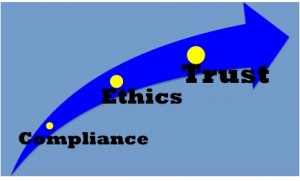
“Every enterprise requires commitment to common goals and shared values. Without such commitment there is no enterprise; there is only a mob. The enterprise must have simple, clear, and unifying objectives. The mission of the organization has to be clear enough and big enough to provide common vision. The goals that embody it have to be clear, public, and constantly reaffirmed. Management’s first job is to think through, set, and exemplify those objectives, values, and goals.”
-Peter Drucker
What happens when a group of open-minded trust, ethics and compliance experts meet for lunch to discuss the intersection of the three disciplines and their respective roles in organizations?
One of the tasks at hand was to create a visual representation of the functional interaction between compliance, ethics and trust in an organization.

What does this mean?
Compliance: While organizations require compliance as a minimum “rule setting/obeying standard,” compliance does not necessarily have an ethics OR a trust mandate. Compliance is merely the starting point, not the end. In fact, it can be trust’s worst enemy when it is assumed that compliance encompasses trust and ethics. Compliance is regulated while ethics and trust are voluntary. In most companies, this distinction is not made and the C&E Officer is usually an attorney who simply enforces the “laws.” He or she may have no understanding of ethics, let alone trust.
Ethics: The “character” component of trust is ethics, and unlike compliance, it is a personal choice. It’s the individual and organizational value system that must be debated, decided and set in place by the Board of Directors, not the CEO. A Chief Ethics Officer, not a C&E Officer, is the distiller of these values. He or she need not be an attorney. So what role does trust play? Unfortunately, both individuals and organizations can be “ethical” without being trustworthy because there are two more attributes that must be present for trust to flourish.
Trust: In order for an individual or organization to be trustworthy it must, at a minimum exhibit not only character (ethics) but competence and consistency in all internal and external relationships. “High trust” companies understand the distinction between compliance, ethics and trust. Going beyond compliance and ethics by adding the trust component results in:
- Less need/emphasis on compliance and it’s oppressive laws and regulations
- Greater employee satisfaction and lower turnover
- Faster decision-making and innovation
- Less risk and fewer crises
- Better relationships not only with customers but all stakeholders
- A happier workplace
- Higher profitability
A trust-based leader is one who commits to trust as a business strategy incorporating and then regularly communicating the values and culture, and mandating and ensuring that those values are meeting the long-term needs of all internal and external stakeholders- shareholders, employees, customers, suppliers, community, etc.
There are certain prerequisites that must be met in order to make this commitment:
- The Board of Directors first, then the CEO & the entire C-Suite must acknowledge and embrace the importance of building trust. The business case has been made but the vast majority of organizations are still ignoring it.
- Building trust is a long-term strategy that may have a short-term negative impact on earnings.
- Trust, as a business strategy requires a certain mindset and “type” of CEO, and a Board that supports this, not only through “talk” but also through action.
- And perhaps most important, building trust cannot be delegated since most organizations have yet to “evolve” to the point of appointing a Chief Trust Officer (CTrO).
To foster trust, the trust-based leader must then:
- Lose the crisis mindset and the “win at all costs” mentality; and refocus from shareholders to stakeholders
- Break down silos by placing “trust” in the center of the business strategy
- Hire according to the organization’s culture and values, and fire for the same reasons
- Explore the myriad of tools available to build organizational trust
- Follow the “Golden Rule” by treating others the way you want to be treated. Become accessible and show some vulnerability.
- Be transparent and always tell the truth even if it may hurt the organization in the short-term
- Place trust “front and center” in every internal and external conversation. Set 2 or 3 annual trust goals and communicate how you are working to achieve them.
- Consider hiring a Chief Trust Officer to sit in the office next to yours
- Display excellence always. Nothing speaks “trust” and ethics louder than character, competence and consistency, sprinkled with a bit of generosity!
- Sit back and watch your profits soar.
There is simply no point in talking about trust if it is not followed by action.
How do you handle trust in your organization or business affairs? What can you add to enrich this discussion? I look forward to hearing your thoughts so please share them on social media.
